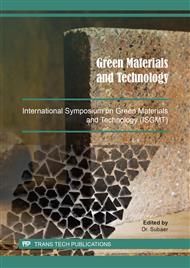[1]
Michael Lauterwein, Margret Oethinger, Klaus Belsner,Thies Peters,Reinhard Marre. (1995), in vitro activities of the lichen secondary metabolites vulpinic acid, (1)-usnic acid, and (2)-usnic acid against aerobic and anaerobic microorganisms. Antimicrobial Agents and Chemotherapy, 39, 2541–2543.
DOI: 10.1128/aac.39.11.2541
Google Scholar
[2]
Zhiheng Zhang, Yu Zheng, Yue Li, Hui Bai, Tianwen Ma, Xiaopeng Song, Jinghua Zhao, Li Gao. (2018), the effects of sodium usnic acid by topical application on skin wound healing in rats. Biomedicine & Pharmacotherapy, 97, 587–593.
DOI: 10.1016/j.biopha.2017.10.093
Google Scholar
[3]
Kristın Ingolfsdottir, Gavin A.C. Chung, Vilhjalmur G. Skulason, Stefan R. Gissurarson, Margret Vilhelmsdottir. (1998) antimycobacterial activity of lichen metabolites in vitro. European Journal of Pharmaceutical Sciences, 6, 141–144.
DOI: 10.1016/s0928-0987(97)00078-x
Google Scholar
[4]
Sassa and Masayuki Igarashi. (1990) structures of (-)-mycousnine, (+)-isomycousnine and (+)-oxymycousnine, new usnic acid derivatives from Phytopathogenic. Agric. Biol. Chem., 54, 2231-2237.
DOI: 10.1080/00021369.1990.10870286
Google Scholar
[5]
Michael A. Conover, Ronald Mierzwa, Arthur King, David Loebenberg, W. Robert bishop, Mohindar Puar, Mahesh Patel, Stephen J. Coval, Joseph Hershenhorn, Gary A. Strobel. 1992 usnic acid amide, a phytotoxin and antifungal agent from Cercosporidium i-ienningsii. Phytochemistry, 31, 2999-3001.
DOI: 10.1016/0031-9422(92)83434-z
Google Scholar
[6]
Huneck, S., Yoshimura, I.. (1996) identification of lichen substances, 2nd ed., Springer, Berlin, New York, London, Singapore, Tokyo.
Google Scholar
[7]
Jonathan McConathy and Michael J. Owens. (2003), stereochemistry in drug action, Journal of Clinical Psychiatry, 5, 70-73.
Google Scholar
[8]
K. Ingolfsdottir. (2002), Molecules of Interest Usnic acid, Phytochemistry, 61, 729–736.
Google Scholar
[9]
Bazin Marc-Antoine, Bazin, Anne-Cecile Le Lamer, Jean-Guy Delcros, Isabelle Rouaud, Philippe Uriac, Joel Boustie, Jean-Charles Corbel, Sophie Tomasi. (2008), Synthesis and cytotoxic activities of usnic acid derivatives. Bioorganic & Medicinal Chemistry, 16 (14), 6860-6866.
DOI: 10.1016/j.bmc.2008.05.069
Google Scholar
[10]
B.N. Meyer, N.R. Ferrigni, J.E. Putnam, L.B. Jacobsen, D.E. Nicholas, J.L. McLaughlin. (1992), bhrine shrimp: a convinient general bioassay for active plant constituent, Planta Medika, 45, 31-34.
DOI: 10.1055/s-2007-971236
Google Scholar
[11]
M.A. Rashida,U, M.A. Majida, M.A. Quader. (1999), Complete NMR assignments of (+)-usnic acid, Fitoterapia, 70,113-115.
DOI: 10.1016/s0367-326x(98)00033-1
Google Scholar
[12]
Dyrkheeva, N., Luzina, O., Filimonov, A., Zakharova, O., Ilina, E., Zakharenko, A., Lavrik, O. 2018. Inhibitory Effect of New Semisynthetic Usnic Acid Derivatives on Human Tyrosyl-DNA Phosphodiesterase 1. Planta Med.
DOI: 10.1055/a-0681-7069
Google Scholar


